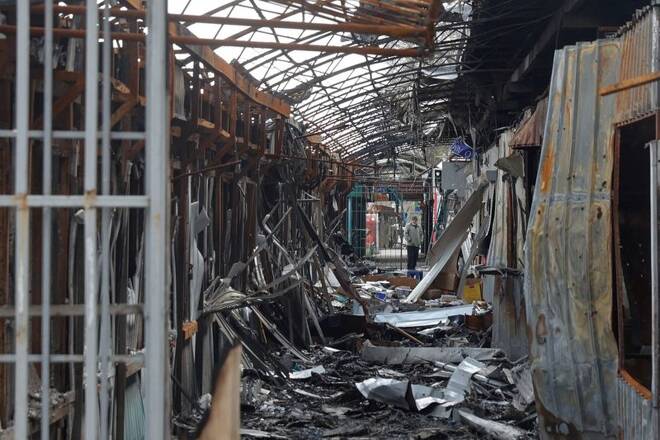Advertisement
Advertisement
Ukraine’s Zelenskiy eyes ‘inflection point’ in war as Russia tightens grip on key target
By:
By Pavel Polityuk and Max Hunder KYIV (Reuters) - Russian forces were attempting to consolidate their hold on Ukraine's industrial city of Sievierodonetsk on Thursday, edging closer to claiming a big prize in their offensive in the eastern Donbas region.
By Pavel Polityuk and Max Hunder
KYIV (Reuters) – Russia tightened its grip on a key target in a battle for control of Ukraine’s eastern Donbas region while President Volodymir Zelenskiy pleaded for more Western arms to help Ukraine reach an “inflection point” and prevail in the war.
Zelenskiy told Luxembourg’s parliament via videolink on Thursday that Russian forces now occupied about a fifth Ukrainian territory, with battle lines stretching more than 1,000 km (620 miles).
As the invasion approaches its 100th day on Friday, Russia says Washington is adding “fuel to the fire” with a new $700 million weapons package for Ukraine that will include advanced rocket systems with a range of up to 80 km (50 miles).
But separately addressing a forum in Slovakia, Zelenskiy said more weapons supplies would “ensure an inflection point in this confrontation,” in Ukraine’s favour.
U.S. President Joe Biden hopes extending Ukraine’s artillery reach will help push Moscow to negotiate an end to a war in which thousands have been killed, cities and towns flattened and more than 6 million people forced to flee the country.
His administration said it had Ukraine’s assurances it would not use the rocket systems to hit targets inside Russia.
“Ukraine is fighting an exclusively defensive war, and we always state this,” the country’s deputy defence minister Hanna Malyar told a briefing when asked whether Kyiv made such a promise.
While Moscow denies targeting civilians it says it regards Ukrainian infrastructure used to bring in Western arms as a legitimate target. Still, it insisted those supplies would not change the course of what it calls a “special military operation” to disarm Ukraine and rid it of ultra-nationalists the Kremlin says threaten Russian security.
“Pumping (Western) weapons into Ukraine does not change all the parameters of the special operation,” Kremlin spokesman Dmitry Peskov told reporters.
“Its goals will be achieved, but this will bring more suffering to Ukraine,” Peskov said when asked whether U.S. plans to sell Ukraine drones that can be armed with missiles could change the nature of the conflict.
Four Russian missiles hit railway infrastructure targets in two places in the western Lviv region bordering Poland late on Wednesday, injuring five people and causing significant damage, its governor said.
Donbas city in focus
Russian forces, backed by heavy artillery, control most of the eastern industrial city of Sievierodonetsk – now largely in ruins – after days of fierce fighting, Britain’s defence ministry said in its daily intelligence report.
Ukraine’s armed forces general staff said that besides its assault on the city, Russian troops were also attacking other parts of the east and northeast.
The capture of Sievierodonetsk and its smaller twin Lysychansk would give Russia control of all of Luhansk, one of two provinces along with Donetsk in the Donbas claimed by Moscow on behalf of separatists.
Seizing Luhansk would accomplish one of Russian President Vladimir Putin’s stated aims and shift battlefield momentum further in Russia’s favour after its forces were pushed back from the capital Kyiv and from northern Ukraine.
Moscow’s forces were also attempting to advance south towards the Ukraine-held cities of Kramatorsk and Sloviansk in Donetsk province, provincial governor Pavlo Kyrylenko said.
Global impact
The war and Western sanctions imposed in response to it are taking a toll on the world economy. With its control of some of Ukraine’s biggest seaports and critical Black Sea shipping routes, Russia has been blocking Ukrainian farm exports and deepening a global food crisis.
Russia and Ukraine together account for nearly a third of global wheat supplies, while Russia is also a key fertilizer exporter and Ukraine a major supplier of corn and sunflower oil.
Interfax news agency quoted Russia’s defence ministry on Thursday as saying that vessels carrying grain could leave Ukraine’s Black Sea ports via “humanitarian corridors” with Moscow ready to guarantee their safety.
Ukraine’s foreign ministry spokesperson said earlier Kyiv was working with international partners on a United Nations-backed solution that would restore shipping routes there.
In another sign of the economic stress, Ukraine’s central bank jacked up its benchmark interest rate to a seven-year high to tackle soaring inflation and shield the hryvnia currency, while its boss called for talks with the International Monetary fund about a new funding programme.
As Washington blacklisted more individuals and entities with ties to the Kremlin, including a major steel producer and a cellist it called Putin’s middleman, the European Union gave final approval to a sanctions package that includes a 90% cut in Russian oil imports by the end of the year. Moscow called the move “self-destructive”, saying it could destabilise global energy markets.
The conflict has also prompted Finland and Sweden to seek NATO membership, though alliance member Turkey has been blocking that move, accusing Stockholm and Helsinki of harbouring people linked to Kurdish militants.
The issue will come up when Biden hosts NATO Secretary-General Jens Stoltenberg at the White House on Thursday.
(Reporting by Reuters bureaux; Writing by Gareth Jones and Tomasz Janowski; Editing by Catherine Evans and Hugh Lawson)
About the Author
Reuterscontributor
Reuters, the news and media division of Thomson Reuters, is the world’s largest international multimedia news provider reaching more than one billion people every day. Reuters provides trusted business, financial, national, and international news to professionals via Thomson Reuters desktops, the world's media organizations, and directly to consumers at Reuters.com and via Reuters TV. Learn more about Thomson Reuters products:
Advertisement
